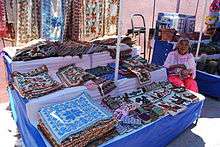Otomi people
|
Otomi dancers from San Jeronimo Acazulco in Mexico state performing the traditional Danza de los Arrieros | |
| Total population | |
|---|---|
| (Mexico:approx >300,000) | |
| Regions with significant populations | |
| Mexico: Hidalgo, EdoMex, Querétaro, Puebla, Veracruz, Guanajuato, Tlaxcala, Michoacán | |
| Languages | |
| Otomi, Spanish | |
| Religion | |
| Predominantly Roman Catholic | |
| Related ethnic groups | |
| Mazahua, Pame, Chichimeca Jonaz, Matlatzinca |
The Otomi people (/ˌoʊtəˈmiː/; Spanish: Otomí Spanish: [otoˈmi]) are an indigenous ethnic group inhabiting the central altiplano (Mexican Plateau) region of Mexico.
Overview

The two most populous groups are the Highland or Sierra Otomí living in the mountains of La Huasteca and the Mezquital Otomí, living in the Mezquital Valley in the eastern part of the state of Hidalgo, and in the state of Querétaro. Sierra Otomí usually self-identify as Ñuhu or Ñuhmu depending on the dialect they speak, whereas Mezquital Otomi self-identify as Hñähñu (pronounced [ʰɲɑ̃ʰɲũ]).[1] Smaller Otomi populations exist in the states of Puebla, Mexico, Tlaxcala, Michoacán and Guanajuato.[2] The Otomi language belonging to the Oto-Pamean branch of the Oto-Manguean language family is spoken in many different varieties some of which are not mutually intelligible.
One of the early complex cultures of Mesoamerica, the Otomi were likely the original inhabitants of the central Mexican altiplano before the arrival of Nahuatl speakers around ca. 1000 CE, but gradually they were replaced and marginalized by Nahua peoples. In the early colonial New Spain period, Otomi speakers helped the Spanish conquistadors as mercenaries and allies, which allowed them to extend into territories that had previously been inhabited by semi-nomadic Chichimecs, for example Querétaro and Guanajuato.
The Otomi traditionally worshipped the moon as their highest deity, and even into modern times many Otomi populations practice shamanism and hold prehispanic beliefs such as Nagualism. Otomies traditionally subsisted on maize, beans and squash as most Mesoamerican sedentary peoples, but the Maguey (Century Plant) was also an important cultigen used for production of alcohol (pulque) and fiber (henequen).
Etymology
The name Otomi comes from the Nahuatl otomitl, which is possibly derived from an older word totomitl "shooter of birds".[3] It is not an Otomi endonym; the Otomi refer to themselves as Hñähñú, Hñähño, Hñotho, Hñähü, Hñätho, Yųhų, Yųhmų, Ñųhų, Ñǫthǫ or Ñañhų depending on which dialect of Otomi they speak.[3][4][cn 1] Most of the variant forms are composed of two morphemes meaning "speak" and "well" respectively.[5]
The word Otomi entered the Spanish language through Nahuatl and is used to describe the larger Otomi macroethnic group and the dialect continuum. From Spanish the word Otomi has become entrenched in the linguistic and anthropological literature. Among linguists, the suggestion has been made to change the academic designation from Otomi to Hñähñú, the endonym used by the Otomi of the Mezquital valley; however, no common endonym exists for all dialects of the language.[3][4][6]
Language
The Otomi language is part of the Oto-Pamean language family, which also includes Chichimeca Jonaz, Mazahua, Pame, Ocuilteco, and Matlatzinca, which belong to the Otomangean language group (consisting of the Amuzgoan, Chinantecan, Mixtecan, Otopamean, Popolocan, Tlapanecan, and Zapotecan language families).

See also
- Otomi (military), an Aztec military order named after, if not composed of, Otomis.
Notes
References
- ↑ See the individual articles for which dialect uses which terms.
- Wright Carr, David Charles (2005). "Precisiones sobre el término 'otomí'" (PDF). Arqueología mexicana. XIII (73): 19. Archived from the original (PDF) on November 8, 2005. Retrieved 2006-12-06. (Spanish)
- Manuscritos Otomies del Virreinato - Paper in Spanish by David Wright Carr
- Otomies en las fuentes - Paper in Spanish by David Wright Carr
- Lengua cultura e historia de los Otomíes Paper in Spanish by David Wright Carr
- Cajero, Mateo Velázquez (2009): Historia de los Otomíes en Ixtenco, San Juan Ixtenco, Tlaxcala, México. (second edition, Spanish book)
External links
| Wikimedia Commons has media related to Otomí people. |
- Pictures of Otomi weaving styles
- Cultura Otomí en Ixtenco, Tlaxcala, México.
- Spring, James (March 14, 2014). "No Place Like Home Act One: Flight Simulation". This American Life. Episode 520. Chicago. WBEZ. Retrieved March 8, 2014. About the "Caminata Nocturna" (a simulated illegal border crossing), in the Hñähñú village of El Alberto, Hidalgo.